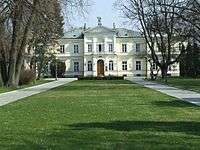Julian Ursyn Niemcewicz
| Julian Ursyn Niemcewicz | |
|---|---|
|
Portrait by Antoni Brodowski  | |
| Born |
6 February 1758 Skoki, near Brest, Polish-Lithuanian Commonwealth |
| Died |
21 May 1841 (aged 83) Paris, France |
| Nationality | Polish |
| Occupation | Poet, playwright, statesman |
Julian Ursyn Niemcewicz (6 February 1758, Skoki, near Brest – 21 May 1841, Paris) was a Polish poet, playwright and statesman. He was a leading advocate for the Constitution of 3 May 1791.
Biography

Niemcewicz, scion of a moderately well-to-do Polish noble family, graduated from the Warsaw Corps of Cadets. He subsequently served as aide to Adam Kazimierz Czartoryski and visited France, England and Italy. Niemcewicz served as a deputy to the Great Sejm of 1788–92 and was an active member of the Patriotic Party that pushed through adoption of the historic Constitution of 3 May 1791. He was subsequently a founder of the Friends of the Constitution, formed to support the implementation of that progressive document. After the victory of the Targowica Confederation in 1792 and the consequent overthrow of the May 3 Constitution, Niemcewicz, along with other Patriotic Party members, emigrated to Germany.
During the Kościuszko Uprising (1795), Niemcewicz served as aide to Tadeusz Kościuszko. Both were captured by the Russians at the Battle of Maciejowice (1794) and imprisoned in the Peter and Paul Fortress at St. Petersburg along with Niemcewicz's aide-de-camp named Kuźniewski.[1] In 1796, on the death of Tsaritsa Catherine the Great, they were released by Tsar Paul I and made their way together to the United States, where in 1800 Niemcewicz married Mrs. Livingston Kean, widow of John Kean, a delegate from South Carolina to the Continental Congress.[2]
Niemcewicz was upset when Kościuszko decamped for Europe without giving him any notice.[3] After Napoleon's 1807 invasion of Poland, Niemcewicz returned to Warsaw and was made secretary of the senate.[2] After the Congress of Vienna, he was secretary of state and president of the constitutional committee in Poland. In the years of the Kingdom of Poland Niemcewicz was the central figure of Polish cultural life and his moral influence was sometimes compared with political and military strength of Grand Duke Constantine.
On 11 May 1830 he unveiled a new landmark before the Staszic Palace, the seat of the Society of Friends of Science in Warsaw — a monument to Nicolaus Copernicus sculpted by Bertel Thorvaldsen. During the failed November Uprising of 1830–31, Niemcewicz was a member of the insurrectionary Polish government. In the final months of the Uprising the poet went on a diplomatic mission to London (as the last Polish envoy to Britain) and he remained in exile, first in Britain, then in France, until his death in 1841.
He died in 1841 in Paris, France, aged 83.
Writing

As a writer, Niemcewicz tried many styles of composition. His political comedy, The Return of the Deputy (1790), enjoyed great acclaim. His novel, John of Tenczyn (1825), written in the style of Sir Walter Scott, gives a vigorous picture of old Poland. He also wrote a History of the Reign of Sigismund III (3 volumes, 1819) and a collection of memoirs for ancient Polish history (6 volumes, 1822–23).
Niemcewicz's 1817 pamphlet Rok 3333 czyli sen niesłychany (The Year 3333, or an Incredible Dream), first published posthumously in 1858, describes a Poland transformed into a sinister Judeo-Polonia. The pamphlet has been described as "the first Polish work to develop on a large scale the concept of an organized Jewish conspiracy directly threatening the existing social structure."[4] His collected works were published in 47 volumes at Leipzig in 1838-40.
Works
- Władysław pod Warną (Władysław at Varna, 1788)
- Kazimierz Wielki (Kazimierz the Great, 1792)
- Powrót posła (The Return of the Deputy, 1791)
- Na hersztów targowieckich (The Targowica Chiefs)
- Podróże historyczne po ziemiach polskich (Historic Travels over the Polish Lands)
- Śpiewy historyczne (Historic Songs)
- Dzieje panowania Zygmunta III (A History of the Reign of Zygmunt III)
Notes
- ↑ Kneski, John. "The History of the Kuźniewski Clan of Koziebrody". Kuzniewski & Kneski Genelaogy - The History of the Kuźniewski Family. Prof. John Kneski. Retrieved 2 April 2016.
- 1 2
 Wilson, James Grant; Fiske, John, eds. (1900). "Niemcewicz, Julian Ursin, Count". Appletons' Cyclopædia of American Biography. New York: D. Appleton.
Wilson, James Grant; Fiske, John, eds. (1900). "Niemcewicz, Julian Ursin, Count". Appletons' Cyclopædia of American Biography. New York: D. Appleton. - ↑ Niemcewicz, Under Your Vine and Fig Tree.
- ↑ Magdalena Opalski, Israel Bartal, Poles and Jews: A Failed Brotherhood, University Press of New England, 1992.
References
| Wikimedia Commons has media related to Julian Ursyn Niemcewicz. |
- Julian Ursyn Niemcewicz, Under Your Vine and Fig Tree, Mechie J. Budka, editor.
- Attribution
 This article incorporates text from a publication now in the public domain: Chisholm, Hugh, ed. (1911). "Niemcewicz, Julian Ursin". Encyclopædia Britannica (11th ed.). Cambridge University Press.
This article incorporates text from a publication now in the public domain: Chisholm, Hugh, ed. (1911). "Niemcewicz, Julian Ursin". Encyclopædia Britannica (11th ed.). Cambridge University Press.
Bibliography
- Marek Żukow-Karczewski, Niemcewicz mniej znany (Niemcewicz less known), "Życie Literackie", No. 27, 1989, p. 10. (in Polish)